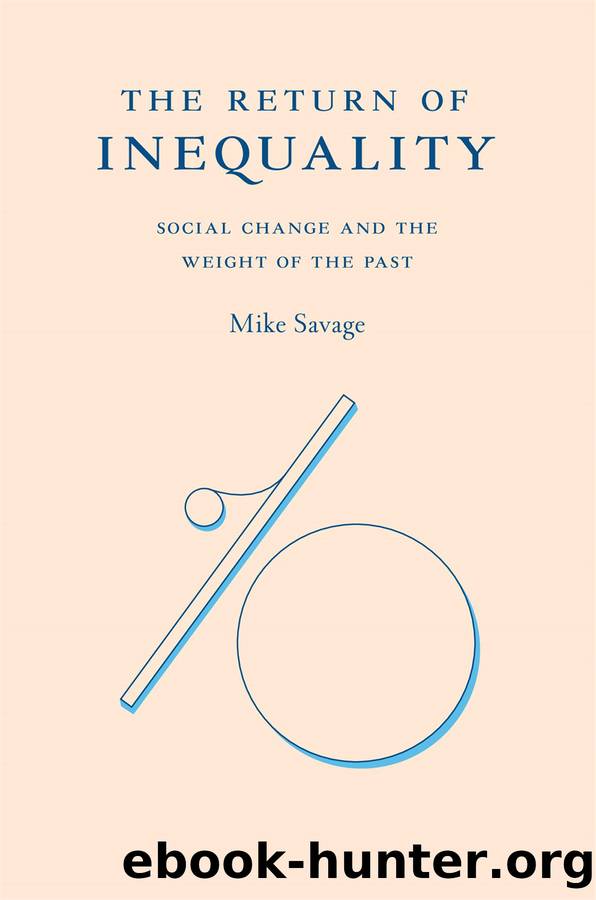The Return of Inequality by Mike Savage

Author:Mike Savage
Language: eng
Format: epub
Publisher: Harvard University Press
7.5: Visceral Inequalities and Economic Inequality
In Chapter 1, we examined the far-reaching shift that economists have staged in making inequality concrete through turning the telescope on wealthy elites, away from their long-standing attention to the poor. Whereas historically it has been the bodies of the poor that commanded attentionâdisreputable, lower class, and racially excluded, as objects of pity and repulsionâit is increasingly the obscene bodies of bloated elites that have been brought into view. Pikettyâs deployment of income-share analysis, and its capacity to mine down in highly granular detail into very small percentiles at the top of the distribution captured the zeitgeist perfectly on its publication in 2013. Rather than hiding behind abstractions, such as the Gini coefficient, a top economist had made it scientifically acceptableâindeed cutting-edgeâto zoom in minutely to real, excessively wealthy people.
This turns out to have huge implications. By portraying prominent elite figures, marked by their wealth, power, and privilege, peopleâs relative lack can more readily be turned into anger and resentment. This is why the visceral inequalities experienced by women, racial minorities, and those from disadvantaged classes are not best understood as performative or identity based. They come to the fore when relative inequalities decline, so encouraging the sense that mobility should be possibleâbut also when the actual concentration of top-level inequalities leads in the other direction. The impossibility of ever winning the game, however hard you playâand even if you obtain a certain measure of successâbecomes ever more apparent as the biggest victors forge further ahead. The overarching hold of those at the top who stand above you, judging you, and ultimately finding you wanting, becomes more grating. In this context, we can understand the anger expressed toward statues of Cecil Rhodes or General Lee not as purely symbolic struggles, or just as trying to set the historical record straight, but testify to the resurgent anger toward elitesâin the form of powerful white menâwho increasingly characterize the âstuff of inequality.â
Visceral inequalities are linked to the changing dynamics of capital accumulation. The rise of relative categories was associated with economic growth based on productivity increases (or in Marxâs terms, the shift from absolute to relative surplus value). As productivity growth in the expanding service sector is increasingly driven by workerâs embodied qualities, where face-to-face and personal interaction plays a key role in making transactions, then physical appearance and deportment come to the fore. There is indeed an arresting feature of much visceral politics, which is that those who feel violated, abused, disrupted, and personally affronted include those who are in relativelyâthough not supremelyâprivileged positions. In this vein, McLaughlin, Uggen, and Blackstoneâs (2012) summary of research on sexual harassment shows that women in supervisory positions are more likely to report being subject to sexual harassment compared to lower-grade female employees. Rather than supervisory status giving insulation from harassment, it works the other way around. Friedman (2016) shows that it is often highly successful and upwardly mobile people in professional and managerial jobs who feel most personally unsettled
Download
This site does not store any files on its server. We only index and link to content provided by other sites. Please contact the content providers to delete copyright contents if any and email us, we'll remove relevant links or contents immediately.
International Integration of the Brazilian Economy by Elias C. Grivoyannis(84332)
The Radium Girls by Kate Moore(11845)
Turbulence by E. J. Noyes(7884)
Nudge - Improving Decisions about Health, Wealth, and Happiness by Thaler Sunstein(7443)
The Black Swan by Nassim Nicholas Taleb(6925)
Rich Dad Poor Dad by Robert T. Kiyosaki(6300)
Pioneering Portfolio Management by David F. Swensen(6157)
Man-made Catastrophes and Risk Information Concealment by Dmitry Chernov & Didier Sornette(5862)
Zero to One by Peter Thiel(5618)
Secrecy World by Jake Bernstein(4584)
Millionaire: The Philanderer, Gambler, and Duelist Who Invented Modern Finance by Janet Gleeson(4278)
Skin in the Game by Nassim Nicholas Taleb(4115)
The Age of Surveillance Capitalism by Shoshana Zuboff(4103)
The Money Culture by Michael Lewis(4008)
Bullshit Jobs by David Graeber(3977)
Skin in the Game: Hidden Asymmetries in Daily Life by Nassim Nicholas Taleb(3858)
The Dhandho Investor by Mohnish Pabrai(3623)
The Wisdom of Finance by Mihir Desai(3590)
Blockchain Basics by Daniel Drescher(3412)
